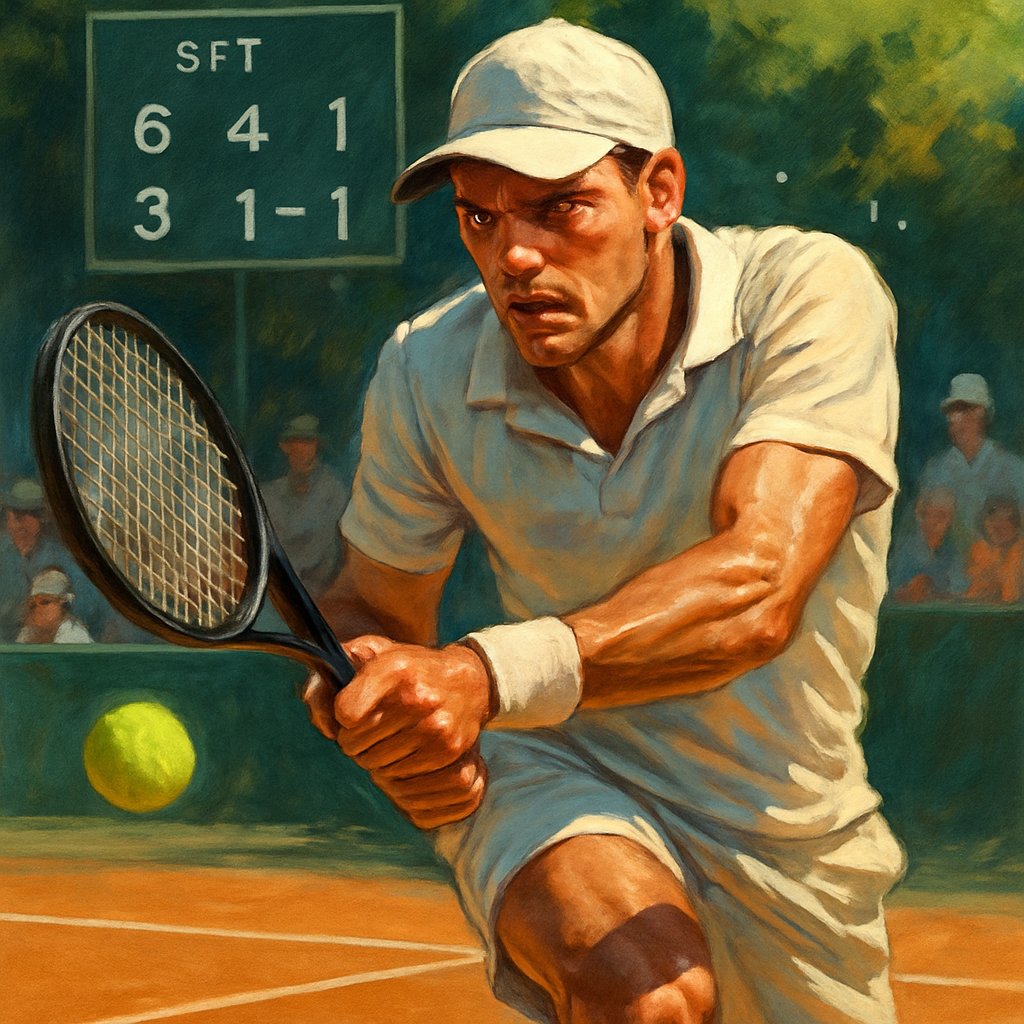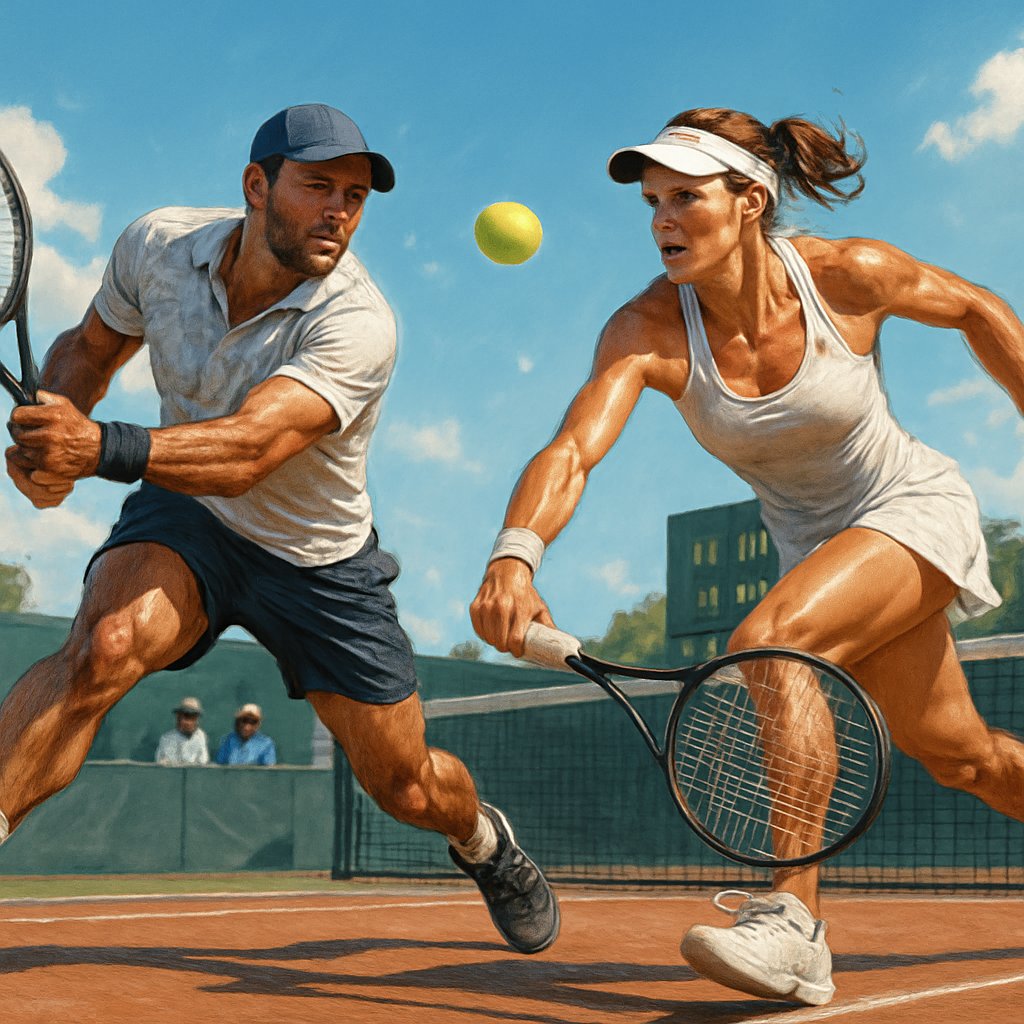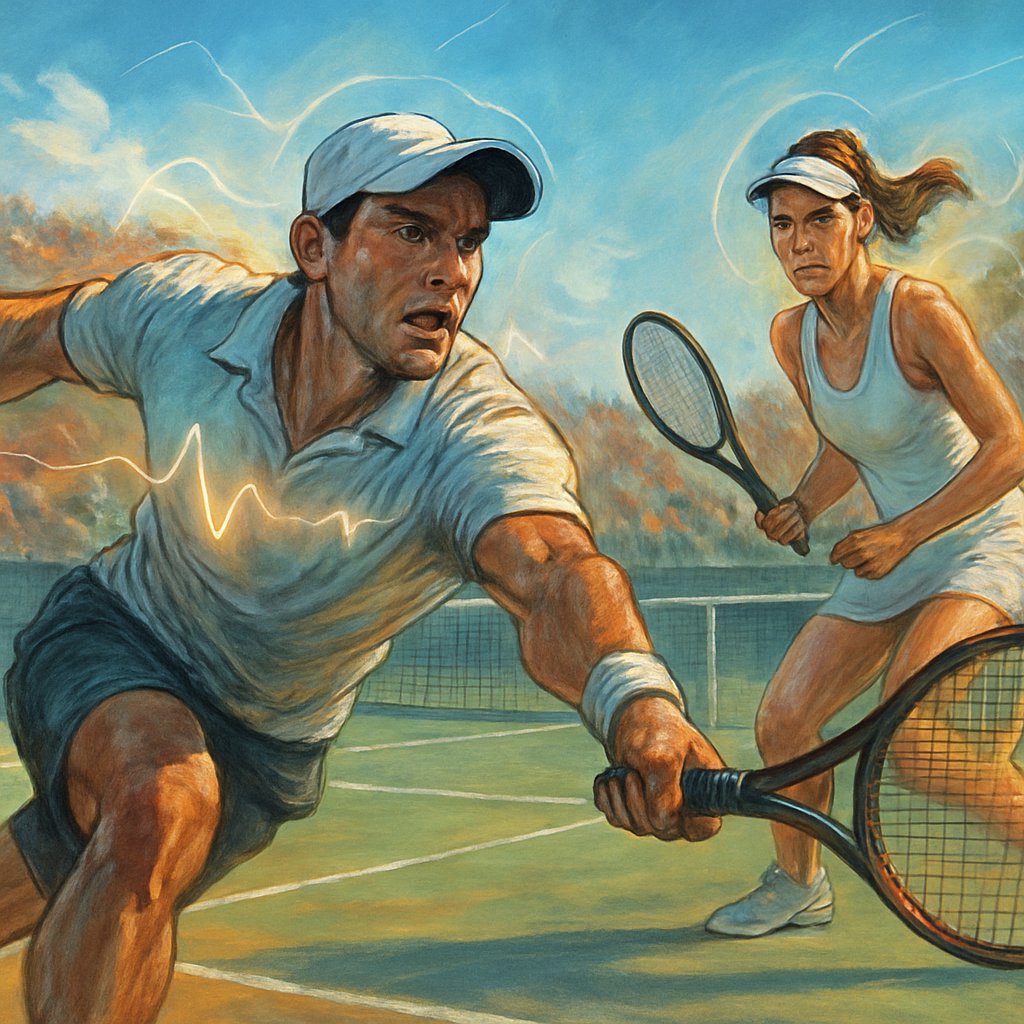Tennis matches can stretch for hours. They test every part of your physical and mental strength.
Building Tennis Endurance is essential for any player looking to improve their game.
Three-set matches really push players to their limits. You need sustained energy from the first serve to the final point.
Training specifically for Tennis Endurance helps athletes maintain their level throughout the match.
A lot of players start strong but fade in the third set. That’s when the match is often decided.

Building proper endurance through targeted training, smart nutrition, and mental prep is crucial if you want to stay competitive in all three sets. Your body needs specific conditioning to handle tennis’s stop-and-go rhythm while keeping your power and focus up.
To achieve Tennis Endurance, focus on workouts that enhance both aerobic and anaerobic fitness.
Without solid endurance, your shots lose their edge. Your movement slows down, and your strategy can fall apart.
The difference between winning and losing often comes down to who handles fatigue best. Smart training mixes cardio, strength, and mental toughness to keep you sharp in those clutch third-set moments.
Incorporating Tennis Endurance training can make a significant difference in your performance.
Key Takeaways
- Mix cardio training with tennis drills to build stamina for long matches.
- Good nutrition and hydration before, during, and after matches help keep your energy up.
- Mental prep and recovery routines help you stay focused and avoid injuries during long play.
The Demands of Three-Set Tennis Matches
Understanding the demands of Tennis Endurance can prepare players for the challenges they face.

Three-set tennis matches test both your body and your mind in ways that short matches just can’t. You face unique challenges that call for specific prep and endurance strategies.
Focusing on Tennis Endurance allows players to manage their energy levels effectively.
Physical Requirements for Extended Matches
Your cardiovascular system really gets a workout during three-set matches. These contests often last anywhere from two to four hours, so you need both aerobic capacity and explosive power.
Strong legs help you handle the thousands of quick changes in direction. Your core keeps you stable through endless groundstrokes and serves.
You’ll also need upper body strength to keep your shots powerful deep into the match.
Key physical demands include:
- Running the equivalent of 3-5 miles on the court
- Making 300-500 directional changes
- Keeping your stroke technique solid even when tired
- Recovering quickly between points (usually 20-25 seconds)
Your heart rate often stays between 150-180 beats per minute. That kind of intensity means you need both aerobic endurance and anaerobic power for those big points.
Training for Tennis Endurance should include a variety of exercises to build overall fitness.
Dehydration can become a real problem. You might lose 2-4 pounds of water weight in a long match.
Your body also has to work extra hard to regulate temperature, especially once matches go past the two-hour mark.
Common Challenges in Men’s Tennis
Men’s tennis brings its own set of endurance challenges. The matches are longer, there’s no shot clock, and rallies can drag on.
Men’s tennis often emphasizes the importance of Tennis Endurance due to longer match times.
Physical challenges:
- Serving at 120+ mph in the third set is tough to maintain
- Aggressive baseline play for hours wears you down
- Staying focused through all the momentum swings isn’t easy
Serve speed usually drops by 10-15% in the last set if you haven’t trained for it. Leg cramps are pretty common after two hours on court.
The scoring system doesn’t help. You can’t control how long the match will last—sometimes three sets stretch into four hours with multiple tiebreaks.
Many players find that developing Tennis Endurance helps them perform better in critical moments.
Differences Between Recreational and Professional Play
Pros train 4-6 hours a day with intense fitness programs. Most recreational players practice 3-5 times a week, often with less focus on endurance.
Key differences:
Training regimens that prioritize Tennis Endurance will lead to improved match outcomes.
| Aspect | Professional | Recreational |
|---|---|---|
| Match duration | 2-4 hours | 1.5-2.5 hours |
| Rally length | 6-8 shots average | 4-6 shots average |
| Recovery time | Ice baths, massage | Basic rest |
| Fitness level | Elite conditioning | Variable fitness |
Your shot selection can get sloppy when you’re tired. Pros stay sharp longer thanks to better conditioning and mental training.
Court surface matters, too. Clay courts stretch points and matches, while hard courts demand more explosive movement that can wear out recreational players faster.
Training Strategies to Build Tennis Endurance

Building tennis endurance isn’t just about running laps. The best training programs mix aerobic workouts, intervals, and court drills that actually reflect what happens in a match.
Incorporating drills that focus on Tennis Endurance can prepare you for high-pressure situations.
Aerobic and Strength Conditioning
Long runs help lay the groundwork for tennis endurance. Shoot for 30-45 minutes at a steady pace to boost your cardio base.
A weekly aerobic schedule might look like:
-
- 2-3 long runs
Players should dedicate part of their training to enhancing Tennis Endurance.
- 1 swimming session for low-impact cardio
- 1-2 cycling workouts
Strength training matters, too. Focus on legs, core, and shoulders with compound moves.
Key strength exercises:
-
- Squats and lunges for legs
- Planks and Russian twists for core
- Pull-ups and shoulder presses for upper body
Focusing on Tennis Endurance can help players maintain sharpness throughout lengthy matches.
Hit the weights 2-3 times a week with moderate loads and higher reps. You’re aiming for muscular endurance, not just brute strength.
Interval and Agility Workouts
High-intensity intervals mimic tennis’s stop-and-go feel. Push hard for a bit, then recover, just like in real points.
Try this workout:
Drills that mimic match conditions are vital for building Tennis Endurance.
- Sprint 30 seconds
- Walk for 90 seconds
- Repeat 8-10 times
Agility drills help you move better on court. Lateral shuffles, cone drills, and ladder work all make your footwork more efficient.
Effective agility drills:
- Side shuffles with racquet swings
- Figure-8 runs around cones
- Ladder footwork patterns
Do interval training twice a week. Mix in agility drills 2-3 times a week, but keep sessions short and sharp to avoid burning out.
On-Court Practice Drills
Court-specific drills get you ready for real match conditions. Extended rallies with a partner or coach simulate the grind of long points.
Set up baseline rallies that last 2-3 minutes. Focus on consistency, not hitting winners.
Consistent practice can greatly enhance Tennis Endurance over time.
Solid on-court drills:
- Continuous groundstroke rallies
- Side-to-side movement patterns
- Serve and return sequences
Play practice sets with shorter rest between points to train your body to recover quickly—just like in a real match.
Fueling and Hydration for Optimal Performance
Nutrition plays a critical role in supporting Tennis Endurance, especially during matches.

What you eat and drink can make or break your performance in long matches. Strategic fueling and hydration before, during, and between sets help you fight off fatigue and stay sharp.
Understanding your body’s needs can improve your Tennis Endurance significantly.
Pre-Match Nutrition Essentials
Eat your main meal three to four hours before your match. Go for foods high in carbs and moderate in protein, but keep fats low.
Good pre-match foods:
- Pasta with lean chicken
- Rice with grilled fish
- Oatmeal with banana and honey
- Whole grain toast with peanut butter
Skip high-fiber, spicy, or unfamiliar foods. You want stuff that sits well with your stomach.
If you get hungry 1-2 hours before playing, have a light snack. A banana, energy bar, or a few dates work well.
Stop eating solids at least 30 minutes before you start. Give your stomach a chance to settle.
Hydration Before and During Play
Start hydrating 2-3 hours before your match. Aim for 16-20 ounces of water in that window.
Drink another 8-10 ounces about 15-20 minutes before you hit the court. If your urine is pale yellow, you’re probably good to go.
During play:
- Drink 4-6 ounces every 15-20 minutes
- Use sports drinks for matches over an hour
- Take sips on changeovers and between points
Sports drinks help replace lost electrolytes. Look for ones with 6-8% carbs for the best effect.
Don’t wait until you’re thirsty. By then, dehydration has already started to mess with your game.
Smart Snacking Between Sets
Keep between-set snacks simple and easy to digest. You only have a short break, so grab something quick.
Best options:
Snacking strategically can support your Tennis Endurance during matches.
- Banana slices
- Energy gels or chews
- Dates or dried fruit
- Sports drinks with carbs
Take tiny bites every changeover if the match drags on. A little banana or a sip of sports drink can keep your energy from crashing.
Skip high-fat or protein-heavy foods during play. They’re tough to digest and can make your stomach rebel.
Time your eating so you finish snacks at the start of a break, not right before the next point.
Mental Resilience for Three-Set Battles

When matches go the distance, your mind can be your biggest weapon. Building mental toughness helps you stay calm under pressure and recover from rough patches.
Having a solid mental game is crucial for maintaining Tennis Endurance.
Staying Focused Under Pressure
Three-set matches bring more pressure points than quick matches. Sometimes one point can flip everything.
Practicing mental resilience will aid you in managing your Tennis Endurance during tough points.
Try to focus on each point as it comes. Don’t let your mind wander to the score or what could happen next.
Use controlled breathing between points. Take two deep breaths before serving or returning to help reset your focus.
Pick one technical cue for high-stress moments. Maybe it’s your follow-through or your footwork—zero in on that when things get tense.
Lots of pros use positive self-talk. Simple phrases like “stay calm” or “trust your shots” can help quiet the noise in your head.
Effective Pre-Match Routines
Mental prep starts well before you step on court. A good routine can help cut down nerves and boost your confidence.
Visualization works best if you do it often. Spend 10-15 minutes picturing yourself handling tough points and staying cool in the third set.
Stick to the same warm-up every time. Use the same stretches and hitting routine before each match so your mind feels ready.
Set realistic goals, like “attack second serves,” rather than just “win in straight sets.”
Listen to music that puts you in the right mood. Pick songs that make you feel confident but not too hyped.
Coping With Momentum Swings
Momentum shifts are part of every long match. How you handle them can make a huge difference.
Expect that momentum will swing. If you know it’s coming, it won’t throw you off as much.
Use the time between games to regroup. Take the full 90 seconds—towel off, fix your strings, and refocus.
Change something small if you lose a few games in a row. Maybe adjust your serving position or your return stance. Sometimes a little change can help reset your mindset.
Stay in the moment, even when things go south. Each point is a new chance to get back on track.
Recovery and Injury Prevention Post-Match

After a long match, your body needs real recovery to avoid injuries and keep your performance up. Active recovery, stretching, and smart habits make all the difference.
Active Recovery Techniques
Active recovery is important for sustaining Tennis Endurance between matches.
Active recovery gets you back on your feet faster than just collapsing on the couch. Light movement keeps blood flowing and helps cut down on muscle soreness.
Take a 10-15 minute walk after your match. It helps clear out waste products from tired muscles.
Try easy cycling or swimming the next day. These activities move your body without adding more stress.
Good active recovery options:
-
- Walking or light jogging
- Easy bike rides
Light activities can enhance your Tennis Endurance and promote recovery.
- Pool exercises or gentle swimming
- Yoga or tai chi
Remember to stay hydrated during recovery. Your muscles need water to repair and bounce back.
Stretching and Cool-Down Protocols
Stretching after tennis keeps your muscles loose and helps you stay flexible. Try to start within 30 minutes after you finish playing.
Hold each stretch for 15-30 seconds. Don’t bounce—move slowly and focus on the muscles you used the most.
Essential post-match stretches:
- Hamstring stretches (back of thighs)
- Quad stretches (front of thighs)
- Calf stretches (lower legs)
- Shoulder and chest stretches
- Hip flexor stretches
Take deep breaths as you stretch. It really helps your body relax, and you’ll notice a difference in how the stretch feels.
If you have a foam roller, use it on tight areas. Roll gently for 30-60 seconds on each sore spot.
Preventing Overuse Injuries
Tennis puts you at risk for overuse injuries because of all the repeated movements. You’ve got to be proactive if you want to stay healthy.
Rest days are important. Your body needs time to recover, so plan at least one full day off each week.
Strengthen the muscles that support your tennis game. Work on your core, shoulders, and legs with simple exercises.
Key injury prevention habits:
-
- Warm up before matches
Proper technique is essential for maintaining Tennis Endurance and preventing injuries.
- Use good technique every time you play
- Change your tennis shoes when they wear out
- Pay attention to your body’s pain signals
Ice sore spots for 15-20 minutes after you play. This can help with inflammation. Don’t ice for more than 20 minutes.
Recovery strategies can improve your Tennis Endurance and keep you performing at your best.
Frequently Asked Questions

Building endurance for three-set matches takes more than just running laps. You need to train your body and mind if you want to compete at your best, especially when things get tough.
What are effective cardio exercises specifically tailored for tennis players?
Incorporating Tennis Endurance training into your regimen can greatly benefit your performance.
Interval running fits tennis’s stop-and-start pace. Sprint for 30 seconds, jog for 60, and repeat that 10-15 times.
Jump rope is great for foot speed and coordination. Try three-minute rounds with a one-minute rest in between.
Cycling is easy on your joints but still works your legs. Go for 45-60 minutes at a moderate pace.
Stair climbing builds explosive leg power. Run stadium steps or hit a stair machine for 20-30 minutes.
Part of building Tennis Endurance is understanding the importance of varied training.
How does one develop mental resilience to remain focused during long tennis matches?
Try visualization before matches. Imagine yourself staying calm during tough points and long rallies.
Use positive self-talk between points. Swap out negative thoughts for reminders like “stay focused” or “next point.”
Control your breathing during changeovers. Take deep breaths to slow your heart rate and clear your mind.
Set small goals as you play. Focus on the next game instead of worrying about the whole set.
What constitutes a good off-season tennis workout program to build endurance?
Run three or four times a week. Mix up long runs (30-45 minutes) with interval training.
Strength train twice a week. Prioritize squats, lunges, and core work.
Stretch or do yoga for 15-20 minutes a day. Mobility work pays off over time.
Fit in tennis drills once or twice weekly to keep your skills sharp while you build fitness.
What running drills can improve on-court endurance for tennis athletes?
Suicide runs mimic tennis movement. Sprint to the service line, back to baseline, then to the net and back again.
Lateral shuffles help with side-to-side stamina. Shuffle 10 yards right, then left, for 30 seconds at a time.
Cone drills boost agility and stamina. Set up cones in court patterns and practice quick direction changes.
Can you suggest power exercises that are most beneficial for tennis players’ endurance?
Plyometrics are your friend. Jump squats, box jumps, and lateral bounds all build explosive strength.
Medicine ball throws help with rotational power. Work in overhead slams and side throws.
Burpees mix strength and cardio. Start with three sets of ten reps—tough, but worth it.
How can a Strength and Conditioning Coach improve a tennis player’s performance in three-set matches?
Coaches craft training programs just for tennis. These usually mix strength, speed, and endurance exercises.
A Strength and Conditioning Coach can tailor programs that boost your Tennis Endurance effectively.
They put together plans that ramp up at the right time—ideally, right before tournament season. It’s a bit of a balancing act, honestly.
Coaches also keep an eye on recovery. They’ll tweak workouts if matches pile up, making sure players don’t burn out but still build the stamina needed for those long, gritty matches.
With proper focus on Tennis Endurance, players can achieve remarkable improvements in their game.
